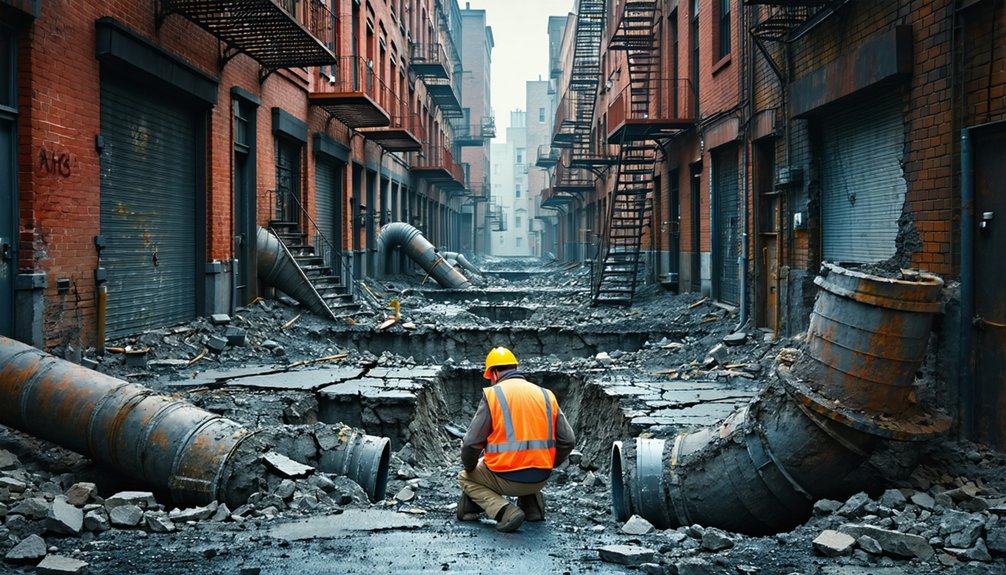Understanding sewer replacement costs involves several key factors. Average repair costs range from $2,500 to $4,000, while full replacements typically cost between $3,000 and $7,000, averaging around $5,000. Various elements influence expenses, including the length and depth of the sewer line, material selection, and site accessibility. Additionally, considering excavation methods, video inspections, and potential hidden costs is essential for accurate budgeting. Exploring these details further reveals critical insights into effective planning for sewer line services.
Average Costs of Sewer Line Repairs and Replacements
The costs associated with sewer line repairs and replacements vary considerably based on several factors, including the method used and the extent of the damage. Sewer line repair averages around $3,500, with typical costs ranging from $2,500 to $4,000. In contrast, full sewer line replacements can average approximately $5,000, with costs spanning between $3,000 and $7,000. Traditional excavation methods for repairs range from $50 to $250 per foot, while trenchless repair methods can cost between $60 and $250 per foot. The extent of damage plays a vital role; minor issues often necessitate repairs, which are generally less expensive than a full replacement. Additionally, factors such as the length and depth of the sewer line, along with its location and accessibility, can complicate installations and increase overall costs. Understanding these financial parameters is essential for homeowners seeking effective sewer line solutions.
Factors Influencing Sewer Replacement Expenses
While various factors can influence sewer replacement expenses, key considerations include the length and depth of the sewer line, the extent of damage, and the accessibility of the installation site. The average cost for sewer line replacement typically ranges from $3,000 to $7,000, with an average around $5,000. Costs increase markedly with the length and depth of the sewer line, as labor and equipment needs can vary widely, particularly with trenchless methods costing between $60 and $250 per linear foot. The extent of the damage is essential; minor repairs may incur costs between $2,500 and $4,000, while severe damage could necessitate a complete replacement. In addition, accessibility issues complicate the excavation process, potentially increasing repair costs. The material used also plays a crucial role, with PVC averaging $4.50 per linear foot compared to cast iron, which may reach $50 per linear foot.
Understanding the Cost Breakdown for Sewer Line Services
Understanding the cost breakdown for sewer line services involves examining various components that contribute to the overall expenses. Homeowners can expect sewer line repair costs to typically range from $2,500 to $4,000, with an average around $3,500. In cases of severe damage to your sewer, full replacements may be essential, costing between $3,000 and $7,000, averaging approximately $5,000. The method of replacement considerably affects costs; traditional excavation methods can range from $50 to $250 per foot, while trenchless repair methods usually range from $60 to $250 per foot, often proving more cost-effective. Additional expenses may arise from video inspection services, typically costing between $100 and $500, which assist in diagnosing sewer line problems accurately. Moreover, homeowners should consider potential landscaping repairs post-excavation, averaging $4.50 to $12 per square foot, as these costs can greatly add to the overall financial commitment.
Frequently Asked Questions
How Much Does a Full Sewer Replacement Cost?
The cost of a full sewer line replacement typically ranges from $3,000 to $7,000, influenced by factors such as replacement materials, soil conditions, and municipal regulations. Contractor fees and plumbing permits can further impact expenses. Utilizing trenchless technology may reduce labor costs and project timelines. Homeowners should also consider inspection requirements and maintenance tips to guarantee long-term functionality. Obtaining multiple estimates can help achieve fair pricing for the necessary services.
How Does Sewer Line Replacement Work?
When addressing the delicate task of revitalizing sewer lines, the replacement process encompasses various methodologies. Skilled professionals utilize advanced inspection methods to assess damage before employing excavation techniques for pipe removal. Choices in pipe materials range from traditional options to innovative solutions, affecting installation timelines. Compliance with local regulations is essential, and while DIY options exist, they require careful consideration. Maintenance tips post-replacement can mitigate future environmental impact, ensuring sustained functionality and service longevity.
How Much Does It Cost to Replace 50 Feet of Sewer Line in California?
The cost of replacing 50 feet of sewer line in California varies widely, influenced by factors such as replacement options, excavation methods, and local regulations. Typical expenses range from $2,500 to $12,500. Contractor fees, labor costs, and pipe materials further affect the total. Additionally, inspection requirements and environmental considerations can lead to unforeseen expenses. Project timelines may extend due to necessary permits or landscaping repairs, impacting overall budget allocation.
What Costs Are Involved in a Sewer System?
The costs involved in a sewer system encompass various factors, including sewer inspection costs, labor expenses, and material selection. Trenchless technology offers an efficient alternative to traditional excavation techniques, impacting overall expenses. Additional costs may arise from permit fees, restoration expenses to landscaping, and compliance with plumbing regulations. Emergency repairs may also escalate costs due to urgent labor needs and potential environmental impacts, necessitating thorough planning to mitigate unforeseen financial burdens.



